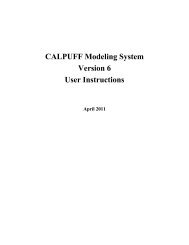Volume 1 - The Atmospheric Studies Group at TRC
Volume 1 - The Atmospheric Studies Group at TRC
Volume 1 - The Atmospheric Studies Group at TRC
Create successful ePaper yourself
Turn your PDF publications into a flip-book with our unique Google optimized e-Paper software.
(IMIXH = 1), or the newly implemented B<strong>at</strong>chvarova-Gryning model is selected<br />
(IMIXH = 2).<br />
CALMET must be started no l<strong>at</strong>er than the hour th<strong>at</strong> ends <strong>at</strong> 0500 in the base time<br />
zone (CET) and it does not need to cre<strong>at</strong>e meteorological fields for hours after the<br />
end of sampling, since no CALPUFF simul<strong>at</strong>ions are made after the sampling<br />
termin<strong>at</strong>es. <strong>The</strong>refore each experiment-day is simul<strong>at</strong>ed in a separ<strong>at</strong>e CALMET<br />
applic<strong>at</strong>ion.<br />
CALPUFF Configur<strong>at</strong>ion<br />
Cameron, Carpinteria, Pismo Beach, Ventura<br />
CALPUFF is applied to each of the OCD4 d<strong>at</strong>asets in the same way, with a unit<br />
emission r<strong>at</strong>e (1 g/s), starting one hour before the first sampling period. <strong>The</strong> peak<br />
simul<strong>at</strong>ed concentr<strong>at</strong>ion each evalu<strong>at</strong>ion hour is retained for comparison with the<br />
corresponding peak observed concentr<strong>at</strong>ion, scaled by the tracer emission r<strong>at</strong>e (e.g.,<br />
Χ/Q).<br />
Tracer emissions are characterized as non-reacting passive Gaussian puffs with no<br />
plume rise. Default plume-p<strong>at</strong>h-coefficient terrain adjustments are used, and ISClike<br />
downwash adjustments are applied to those releases made from bo<strong>at</strong>s and<br />
modeled with downwash in the OCD evalu<strong>at</strong>ions. None of these releases is from a<br />
pl<strong>at</strong>form with significant structures, so the new pl<strong>at</strong>form downwash module is not<br />
tested in these applic<strong>at</strong>ions. Turbulence-based dispersion is selected, with the default<br />
transition to Heffter curves for σ y <strong>at</strong> σ y = 550m.<br />
For each of the five CALMET configur<strong>at</strong>ions, 16 CALPUFF configur<strong>at</strong>ions are run<br />
to identify the performance impact of using all combin<strong>at</strong>ions of:<br />
• Measured versus predicted l<strong>at</strong>eral turbulence (I y )<br />
• CALPUFF versus AERMOD turbulence profiling assumptions<br />
• Draxler (1976) F y curves for sigma-y growth with a fixed Lagrangian<br />
timescale versus a SCIPUFF-like computed Lagrangian timescale<br />
• Minimum σ v = 0.5 m/s (CALPUFF default) versus σ v = 0.37 m/s (OCD<br />
default)<br />
Oresund<br />
CALPUFF is applied to each experiment-day in the Oresund d<strong>at</strong>aset with the actual<br />
emission r<strong>at</strong>e, for the actual release period (in whole hours). <strong>The</strong> resulting hourly<br />
concentr<strong>at</strong>ions are postprocessed using CALPOST to select only those concentr<strong>at</strong>ions<br />
Final Report Vol.1 58







